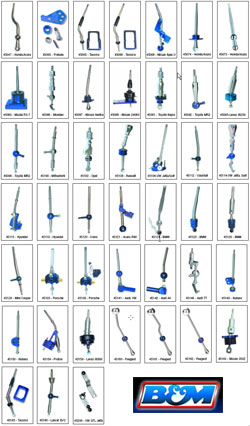
(click
for larger image)
|
|
Secrets of Shifting
(Excerpts from the book: Bob Bondurant On High
Performance Driving)
Gearshift Position and Use
You should treat the gearshift knob as if it were a fresh, raw egg.
By that we mean don’t strangle it or attack it, and don’t slam it
from
gear to gear - you’ll have egg all over your hand. Cup the palm of
your hand over the top of the knob, and let your fingers extend
down the lever shaft to provide guidance.
To shift from first to second, place the cupped palm of your hand on
the knob, fingers down, and use them to guide the lever back into
second, gently. From second to third, just use the heel of your palm
and your wrist, making sure to give it the necessary movement to
the right at the neutral gate. Do it gently and smoothly; don’t slam
it. For the shift from third to fourth, again use your fingers and
your
wrist to guide it back; and for fourth to fifth, again use the heel
off your hand to guide it up. You want to be firm and positive, but
still
gentle and smooth. Remember to always use a gentle hand and wrist
action, rather than a ‘death grip’ and strong arm.
Secrets of Downshifting
Proper downshifting is very important not just in going fast, but
also in driving your car to it’s fullest potential. Unless you learn
to
downshift correctly, your car will never run quickly and smoothly.
The best way to learn your shifting and heel-and-toe downshifting is
to practice it (a lot) before you ever turn your car on or roll it
out of the garage. If you can’t do it right sitting still, you’ll
never get it right
with the car moving. The first problem with heel-and-toe
downshifting is a misconception. Many think that an important reason
for
downshifting is to take advantage of the engine’s braking effect.
That thought has somehow survived from the days of skinny tires, fat
drivers and rapidly fading drum brakes. With the great stopping
power of modern brakes, it is unnecessary, and improper downshifting
is a good way to break high-stressed modern engines. The goal when
downshifting is to change to a lower gear while maintaining
maximum braking, without upsetting the car’s weight transfer and
balance. To do this, there must be a perfect match between engine,
gearbox and rear wheel rpm (or front wheel rpm on a front wheel
drive car), which requires your foot to do ‘double duty’. The
technique
required is called ‘heel-and-toe’, (although heel-and-toe is
something of a misnomer). The term actually was started in the
1950’s with
Ferrari. You should brake with the ball of your right foot, not your
toes. This is equally true for proper heel-and-toe.
Secrets of Heel-And-Toe Downshifting
The function of the right foot in the heel-and-toe downshift is
first to control the braking for the upcoming corner. At the same
time
you’re braking in a straight line and maintaining your brake
pressure, pivot your right heel toward the throttle pedal, squeezing
on
the proper amount of revs, and then pivot back below the brake pedal
as the downshift completes.
Used with permission. Excerpts from the book: Bob
Bondurant On High Performance Driving - 5th Edition Published by
Motorbooks International. Copyright 2024 .
Written by Bob Bondurant & John Blakemore. B&M is proud to have the
Bob Bondurant School of High Performance Driving as a technical
partner. All Bondurant
School cars feature B&M Precision Shifters. |
